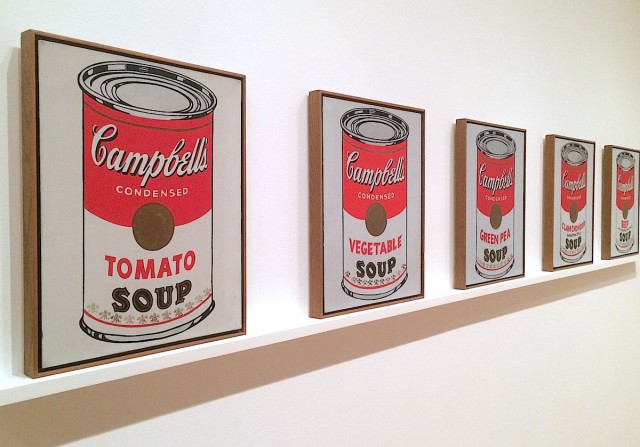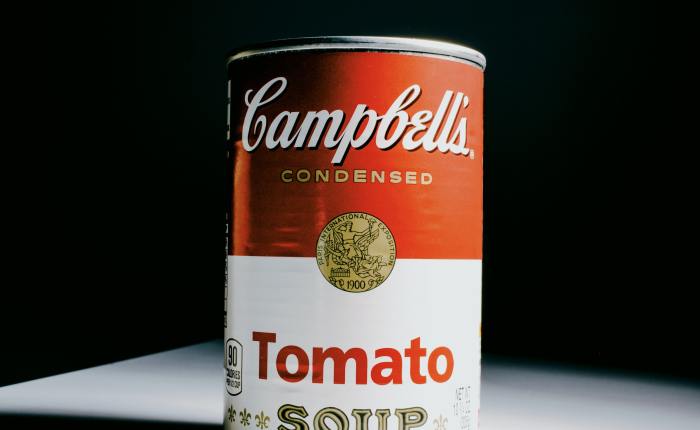When Andy Warhol unveiled his Campbell’s Soup Cans art exhibit in 1962, reactions were closer to befuddlement than praise.
Was this art? Where was the beauty, drama, grandeur, sacredness, or seduction that had previously marked great paintings? And who would pay the exorbitant sticker price of $100 for something that could be purchased at the grocery for ten cents?

Of course, Warhol’s cans now fetch massive sums. One reason was that they offered an ironic critique of modern life. For good and ill, we are now drowning in cheap, mass-produced, pre-packaged, disposable, easily accessible, low quality but quickly replaceable “stuff.” (I originally opted for a different word to end that sentence.)
It’s Campbell’s soup—brought to us by Chinese sweatshops and two-day shipping.
I’ve thought about those Warhol paintings several times of late as I have received Holy Communion.
Out of noble health concerns starting with the COVID-19 pandemic, many churches moved away from traditional Communion methods in favor of individually packaged, disposable, mass-produced, plastic “blister packs” (actual description) like the one seen here.

I agreed with this move and gave thanks for it.
The tiny packages encase a single crumb of bread on one side, and—when you flip them over to remove another “blister” coating—approximately the same amount of liquid as contained within a single teardrop.
In evangelical congregations, I am used to Communion being spoken of as a mere symbol that helps us remember Christ’s sacrifice. “It’s not about the elements,” the pastor may be heard to say. So instead of the Gospel line, “This is my body”—many a minister feels compelled to amend the text to avoid misunderstanding: “This bread represents my body,” etc., etc. “This wine—I mean grape juice…—represents my blood.” I’ve grown accustomed to these things. And truth be told, I am not a believer in something like Catholic transubstantiation.
But I’ve also tired of Communion “blister packs.”
Despite understandable concerns for germs (with which I sympathize), I’ve begun to wonder what the “Oscar Mayer lunchable” approach to the Eucharist says about the modern church—not just on the Lord’s Supper, but on how we value symbols, sacraments, and physicality.
At the risk of overreaction, it sometimes feels as if we have set out to take the most beautiful and sensory-laden sacrament and turn it into something that has the aesthetic value of a roll of bubble wrap.
Even if it doesn’t burst like a juice box in my kid’s backpack, one looks around the sanctuary to see some churchgoers struggling with their teeth and fingernails—like racoons trying to unlock iPhones. By the end of the process, the elements usually find their way into digestive tracts—but something is lost from the meal that Jesus gave us. It has been commodified, sanitized, mass-produced, and individually packaged—like much of modern life.
What, then, is the solution?
My goal is not to add one more curmudgeonly complaint to the endless pile that pastors face. (It has not been easy to lead anything these past few years.) Nor is it to shame one or two churches to switch back to more traditional Communion practices. That too might be a malady of modern ecclesiology: (1) Someone complained. (2) So we stopped.
Instead, what we need is a more holistic way of noticing how unexamined modern values of convenience and commodification have caused us to do strange things in the realm of the sacred.
The French philosopher and theologian, Jacques Ellul, is helpful here. Ellul’s most important work, published back in 1964, is called The Technological Society. He sets forth two key concepts for diagnosing the side-effects that come with mind-blowing technology, inexpensive factory production, frazzled busyness, and consumer competition. He calls them (1) technique and (2) efficiency.
For Ellul, technique is “the totality of methods rationally arrived at and having absolute efficiency in every field of human activity.” Technique aids efficiency; and as we know, being more efficient can save time and money.
To be fair, we can all name aspects of our businesses and bureaucracies that badly need to be streamlined. The trouble, Ellul argues, is that the values of technique and efficiency easily move out of their rightful domains, and they begin to corrupt and commodify the way we relate to people, food, art—and God.
How do you find a mate? Swipe right.
How do I form a nuanced view of Shakespeare’s Othello? ChatGPT.
How do I eat, given that I’m frazzled and rushed? McDonalds.
How do I check “Communion” off my to-do list? Blister packs.
In all these areas, there are costs to maximally efficient solutions.
Moving back to Communion, note how our modern ways of approaching the Eucharist make it difficult to “feel” and “see” what Paul alludes to when he writes to the Corinthians:
“Is not the cup of thanksgiving for which we give thanks a participation in the blood of Christ? And is not the bread that we break a participation in the body of Christ? Because there is one loaf, we, who are many, are one body, for we all share the one loaf.”
1 Corinthians 10:16-17
In the end, I remain grateful for a necessary safety measure in a time of emergency. What’s more, we should probably keep some “blister packs” on hand to love and serve our brothers and sisters who have health concerns.
And as usual, my attempts to be pointed or humorous run the risk of oversimplifying—and overreacting. That too is a byproduct of the marriage of technology and efficiency: What are blog posts if not a maximally efficient form of publishing.
Enjoy your soup. I slaved for minutes over it.
Click the green “Follow” button to never miss a post.
See here to purchase a copy of Perhaps: Reclaiming the Space between Doubt and Dogmatism.
Signup here to receive bonus content through my email Newsletter, “Serpents and Doves.”
